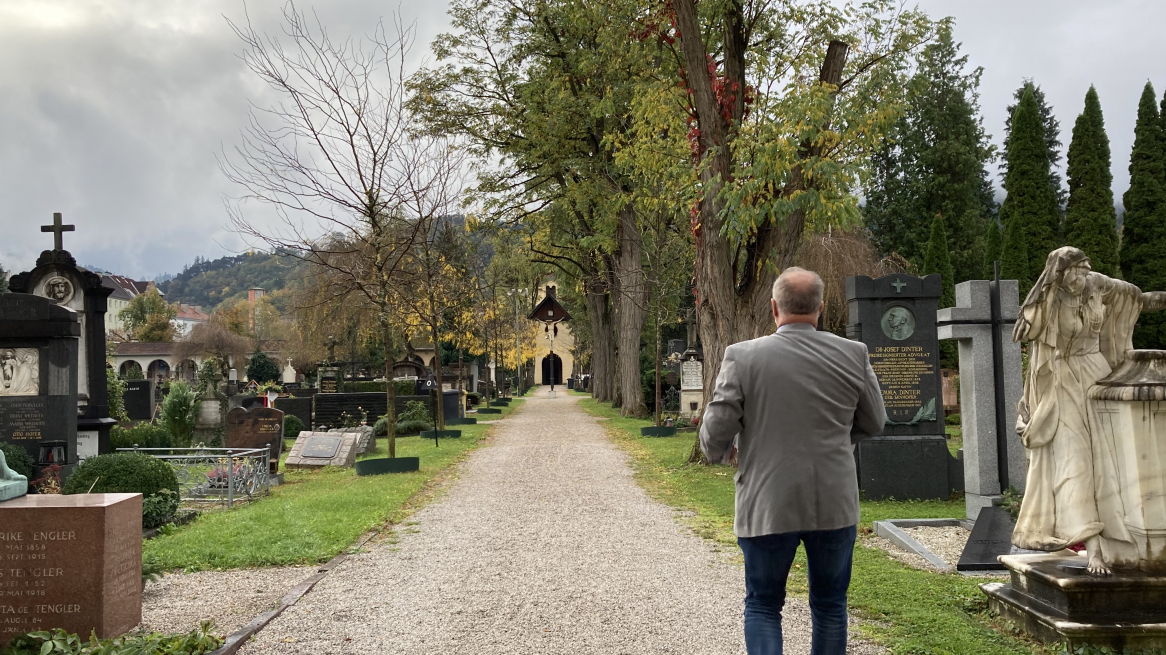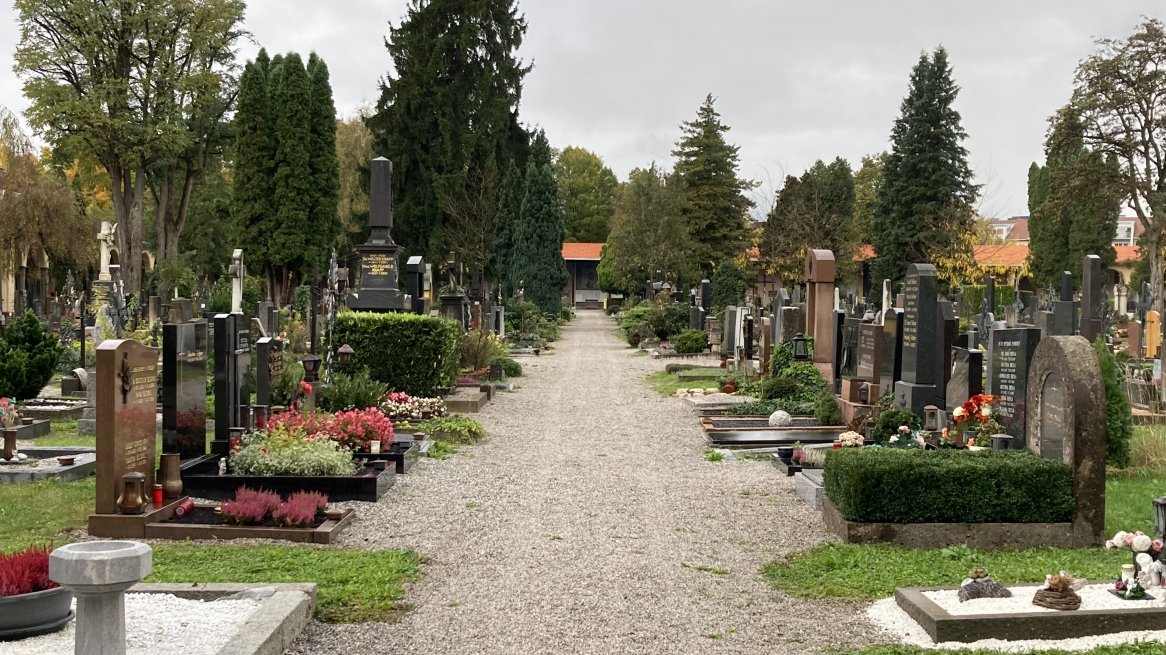
Around All Souls' Day and All Saints' Day, Christians focus on the graves of the deceased and the final resting places are decorated in a special way before winter arrives. There are different traditions and forms of commemoration - such as the Day of the Dead(Día de los Muertos) in Mexico.
Autumn colors
Cemeteries convey a very special atmosphere, especially in the fall. Here too, trees, shrubs and green areas display exciting autumnal colors such as ochre, rusty red, pumpkin yellow and various shades of brown. They provide an exciting contrast to the evergreen plants. Morning dew, or even ripe dew, makes the different tones look particularly intense.
Western cemetery
I've already mentioned in a blog post that I always enjoy wandering through cemeteries. Back then, I visited the picturesque Mühlau cemetery and described the grave of the poet Anna Maria Achenrainer. It is located in the immediate vicinity of that of the important poet Georg Trakl. Recently, a walk took me to the Westfriedhof cemetery, which is located just behind the hospital grounds and is also known as the Wiltener Friedhof.
After the eastern cemetery, the Pradler Friedhof, the western cemetery is the second largest in Innsbruck, covering almost five hectares. There are a total of 21 cemeteries in the city, seven of which are managed by the Innsbruck City Council. The main administration of the cemeteries is located at the Westfriedhof. Built in 1856, it was extended to the same extent around three decades later, creating an almost symmetrical complex to the left and right of the administration building.
Arcades
In the course of the expansion, the main entrance moved from the north to Fritz-Pregl-Straße in the east. It is also interesting to know that the municipal cemetery was originally located near today's cathedral in the old town. It was later located in the area of today's Adolf-Pichler-Platz in the city center, before finally being moved to Wilten. The Jewish cemetery, originally located on "Judenbühel" near the Alpine Zoo, has been located at the southern end of the Westfriedhof cemetery since 1864, as has the Protestant cemetery.
As soon as you enter the West Cemetery, you notice the pretty arcades that line the original part of the West Cemetery. They were decorated by the artists Georg Mader, Franz Plattner, Mathias Schmid and August von Wörndle, but were partially destroyed during the Second World War and then rebuilt. In the southern area, there are only arcades on the north side and part of the east side. The arcades contain the graves of important Innsbruck families.
As you walk through the grounds, looking at individual tombs and graves, you are immersed in the different eras of art history - from Neoclassicism to Art Nouveau and contemporary designs. Attentive observers will also come across well-known names from society, culture, business and politics.
Alexander Legniti, head of the municipal cemeteries, in front of the tomb of politician Martin Rapoldi
Online guide
However, an online guide has been available to interested parties since 2019, allowing them to search for specific graves. After all, there are around 26,000 graves and more than 100,000 deceased people in the cemeteries managed by the city of Innsbruck, as Alexander Legniti, head of Innsbruck's cemeteries, explains. In addition to relatives or acquaintances, it is also possible to locate the graves of Innsbruck personalities.
Such as that of the popular Innsbruck mayor Hilde Zach or that of Peter Walde, founder of the Innsbruck soap factory Walde, today the oldest soap factory in Austria. Or Therese Mölk, who laid the foundation stone for the MPreis grocery chain. The Innsbruck politician Martin Rapoldi is also buried at the Westfriedhof cemetery. The Rapoldi City Park in Pradl is named after him.
During the Second World War, Diana Budisavljevic rescued children from the clutches of the fascist Ustasha.
Diana Budisavljević
Diana Budisavljević, née Obexer, also found her final resting place at the Western Cemetery. Born in Innsbruck, she saved many people during the Second World War, including thousands of children from the concentration camps of the feared Croatian Ustasha regime. For her selfless and intrepid help, Budisavljević was posthumously awarded the Cross of Merit of the City of Innsbruck by the Innsbruck City Council. Since 2021, a memorial plaque has been emblazoned on the Obexer House in Maria-Theresien-Straße in memory of the great humanist. My blogger colleague Danijel Jovanovic has dedicated a blog post to the "silent heroine".
Not far from the Obexer family grave is the name of another benefactor, albeit in a different field. Josefine von Scheuchenstuel founded an orphanage for girls in Innsbruck in 1869 and promoted the education of young women in order to lift them out of poverty.
Marie Zöhrlaut's grave at the Protestant cemetery
The grave cross of the Tyrolean playwright Franz Kranewitter stands out inconspicuously.
Franz Kranewitter
The list of exciting personalities could be continued, right up to the important Tyrolean poet Franz Kranewitter, whose grave is almost unspectacular. However, the grave of Marie Zöhrlaut from Milwaukee immediately catches the eye. The 63-year-old died in Bolzano on April 20, 1893. Her body was transferred to Innsbruck and laid in a stately marble sarcophagus at the Protestant cemetery.
In the Innsbrucker Nachrichten in 1894, apart from a detailed description of the tomb, there is only a note that Zöhrlaut was a "close relative of the local merchant Mr. Max Obexer". The monumental grave, the writer continues, was a special attraction for visitors to the "Gottesacker ". So even in the 19th century there was a keen interest in gravesites and their decoration! And an incentive to go in search of traces yourself, to stroll through the cemetery with open eyes. For there are numerous graves that tell special stories about personalities from this city and about Innsbruck.
Western cemetery
Fritz-Pregl-Strasse 2
6020 Innsbruck
Information on other cemeteries in Innsbruck can be found here.
Photos, unless otherwise indicated: © Susanne Gurschler
Rate this article
Show me the location on the map
Innsbruck has captured her heart, and the view of the Nordkette mountains soothes her soul. A journalist, non-fiction author, bookworm, amateur photographer, dog owner and mountain walker #ghostsofinnsbruck
Similar articles
What do you do when the highest elevation near your home town is only around 150 meters?…
"If the bee disappears from the earth, humans will only have four years to live. No more…
The first time I met Isobel Cope, I was halfway through presenting my radio show Sensations in…
Click. A privacy policy like this is accepted in no time at all. Click. And the computer…













